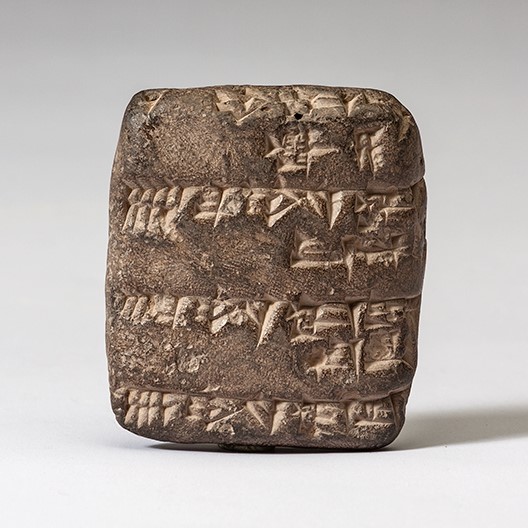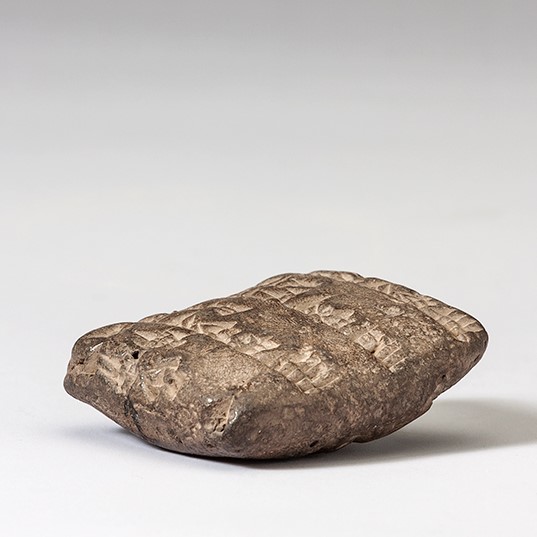Acquisition number: 2006.01
Smoothly finished clay fire a grey-brown; in good condition. The surface is somewhat polished, doubtless through modern handling. The tablet is flatter at the front, curved at the back. The front has four zones of text, the lowest running over virtually onto the bottom edge; on the back the text is in two zones.
Being an account rendered by Ur-Sin for supplying oxen to plough the Sakki-field.
Not dated, but Third Dynasty of Ur, 21st century BC.
Title: Tablet inscribed in cuneiform - 2006.01
Acquisition number: 2006.01
Author or editor: J.R. Green
Culture or period: Sumerian, Third Dynasty of Ur.
Date: 21st century BC.
Material: Clay
Object type: Inscriptions
Dimensions: 17mm (l) × 42mm (w) × 47mm (h)
Origin region or location: Iraq
Origin city: Sumer.
Display case or on loan: 6
Keywords: Sumerian, Third Dynasty of Ur, Inscription, Cuneiform, Mesopotamia
Charles Ede Ltd (London), Catalogue176 (2005) no. 66.
2006.01
Tablet inscribed in cuneiform
Purchased. Ht 4.7cm; width 4.2cm; thickness 1.7cm.
Smoothly finished clay fire a grey-brown; in good condition. The surface is somewhat polished, doubtless through modern handling. The tablet is flatter at the front, curved at the back. The front has four zones of text, the lowest running over virtually onto the bottom edge; on the back the text is in two zones.
Being an account rendered by Ur-Sin for supplying oxen to plough the Sakki-field
Not dated, but Third Dynasty of Ur, 21st century BC.
For similar inscriptions see T. B. Jones and J. W. Snyder, Sumerian economic texts from the Third Ur Dynasty; a Catalogue and Discussion of Documents from Various Collections (Minneapolis 1961, repr. Westport CT, 1974). Although it contains nothing directly relevant to this piece, a recent collection of essays edited by M. Brosius, Ancient Archives and Archival Traditions. Concepts of Record-Keeping in the Ancient World (Oxford 2003) contains some interesting examinations of the processes and systems of archives in the ancient world. Earlier, see E. Posner, Archives in the Ancient World (Cambridge, Mass., 1972) and esp. chapter 1. There is also a good overview by B. André-Salvini, “Les tablettes du monde cuneiforme”, in: É. Lalou (ed.), Les tablettes à écrire de l’Antiquité à l’Époque Moderne. Actes du colloque int. du CNRS, Paris, 10-11 octobre 1990 (Bibliologia 12, Turnhout 1992) 15-33.
For a recent approach to the study of such material, see C. Vandecasteele et al., “Digitising Cuneiform Tablets”, in: A.K. Bowman & M. Brady (eds), Images and Artefacts of the Ancient World (Oxford: British Academy 2005) 31-34. For a recent approach to the study of such material, see C. Vandecasteele et al., “Digitising Cuneiform Tablets”, in: A.K. Bowman & M. Brady (eds), Images and Artefacts of the Ancient World (Oxford: British Academy 2005) 31-34, and now Cuneiform Texts from Babylonian Tablets in the British Museum (CT). One should also be aware of the Keilschrift-Bibliographie which is now available on line: http://vergil.uni-tuebingen.de/keibi/assets/img/keibi.jpg
For an assessment of cuneiform in the broader context of writing systems, see J.T. Hooker et al., Reading the Past. Ancient Writing from Cuneiform to the Alphabet (Berkeley 1991) (C.B.F. Walker).
Charles Ede Ltd (London), Catalogue176 (2005) no. 66.


